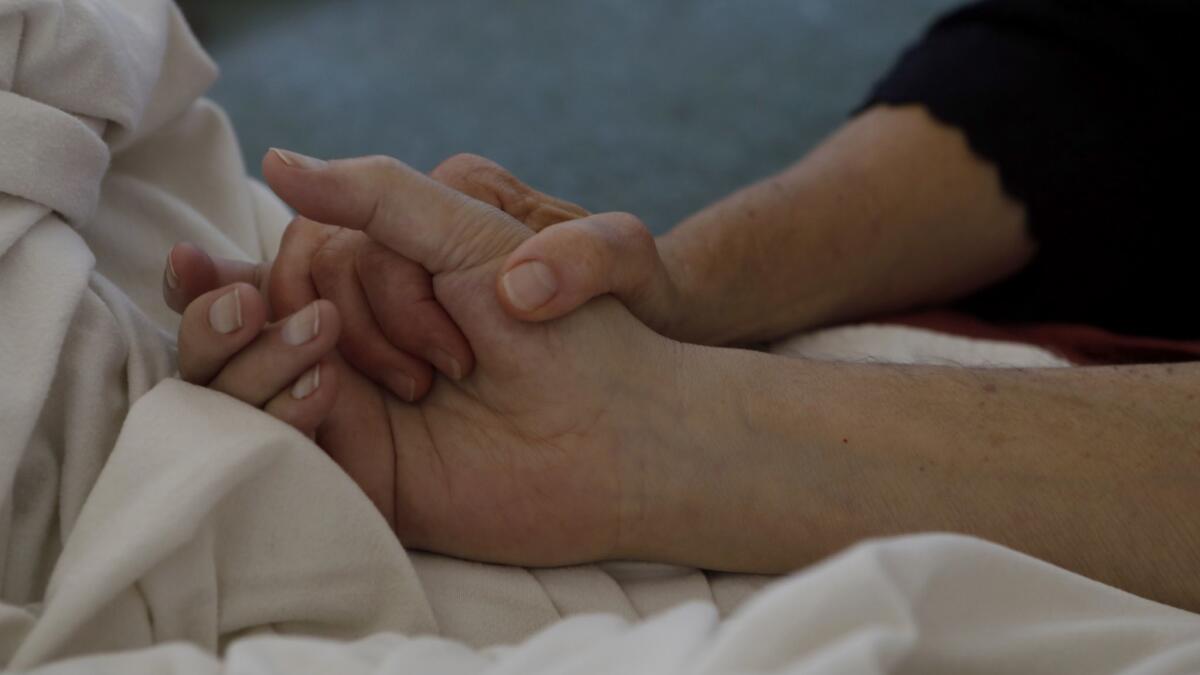Fewer Americans are spending their final days in the hospital and more are dying at home
- Share via
The American way of dying seems to have become less frantic, desperate and expensive.
That’s the upshot of a new study that finds that seniors insured by Medicare who died in 2015 were less likely to do so in a hospital and more likely to pass away in a home or other community setting than those who died in 2000.
The new research also showed that the proportion of American seniors who were admitted to the intensive care unit during their final month of life has stabilized after rising between 2000 and 2009. By 2015, 29% of dying patients insured by Medicare spent part of their final month of life in the ICU.
The study also chronicled a slight decline in the proportion of Medicare patients who spent time on a ventilator during their final days and whose last three days of life were affected by a transfer from one institution to another — say, from a nursing home to the hospital.
The findings were published this week in the Journal of the American Medical Assn. They were based on an analysis of records from 1,361,870 Medicare fee-for-service enrollees and 871,845 Medicare Advantage enrollees who died between 2000 and 2015. Their average age at their time of death was 82.
In all, just short of 20% of Medicare-insured patients who died in 2015 did so in an acute-care hospital, down from 32.6% who did so in 2000. Some 40% of these patients died in a home, hospice, assisted living facility or other community setting in 2015 — up from about 31% in 2000.
Those shifts took place during a period of sweeping changes in U.S. medical care.
As the 21st century got underway, palliative care gained a foothold in U.S. hospitals. This new medical specialty focused on improving the quality of life for very ill patients.
Then, with the adoption of the Affordable Care Act in 2010, hospitals adjusted to new rules aimed at improving the quality of care and reducing expensive patient readmissions.

Meanwhile, doctors and hospitals began a vigorous reassessment of the way they cared for patients who were approaching the end of their lives. Studies chronicled many terminal patients’ tumultuous final days of treatments that were invasive, painful and futile. Other research toted up the traumatic stress experienced by surviving family members.
Physicians began to ask themselves and their patients whether their profession’s dedication to such “heroic measures” were saving patients’ lives — or poisoning their deaths.
In 2014, that debate culminated in a report by the National Institute of Medicine that defined a “good death” as one that is “free from avoidable distress and suffering for patients, families and caregivers” and “in general accordance with patients’ and families’ wishes.”
A patient’s death in the intensive care unit “is seldom viewed as a good death,” concluded the report, issued by the National Academies of Sciences, Engineering, and Medicine.
“There was a greater collective awareness that not all medical interventions are equally beneficial, and that the potential harms of some needed to be weighed,” said Dr. Diane E. Meier, a geriatrician and palliative care specialist who directs the Center to Advance Palliative Care and was not involved in the new research.
A greater focus on the comfort and values of seriously ill patients went hand in hand with the widespread adoption of palliative care teams in hospitals across the United States. These teams included specialists in pain management, mental health, legal and social work, and pastoral care, and they’ve been key in helping clarify what kind of lives — and deaths — patients with serious illnesses want. Then they help those patients and their families plan accordingly.
In 2000, fewer than 20% of hospitals with more than 50 beds had a palliative care team in place. By 2015, close to 70% of such hospitals did, according to a registry maintained by the Center to Advance Palliative Care.
“It’s impossible to say what’s at work here,” said Meier, who underscored that the new study shows a broad trend but does not delineate contributing factors. The changes came against the backdrop of significant shifts in insurance, institutions and professional practices, she said.
The analysis also yielded a wealth of small details about changing practices in end-of-life care.
For example, the study found that the use of hospice services by dying patients increased from 21.6% in 2000 to over 50% in 2015. And the proportion of patients in the study who died after getting only brief hospice services — for three days or fewer — dropped slightly, from 9.8% in 2009 to 7.7% in 2015.
The share of patients who had three or more hospitalizations in their last 90 days of life declined from 11.4% in 2009 to 7.1% in 2015. And the share of patients who spent part of their final four days on a ventilator fell from 3.1% in 2000 to between 2.5% and 2.7% by 2015.
MORE IN SCIENCE
Struggling bumblebees can thrive in an unlikely place: The city
The surprising thing the ‘marshmallow test’ reveals about kids in an instant-gratification world
Surprising discovery about viruses and Alzheimer’s disease could open new avenues for treatment







